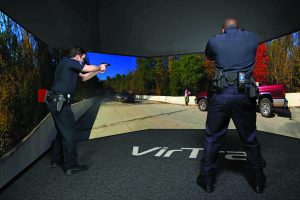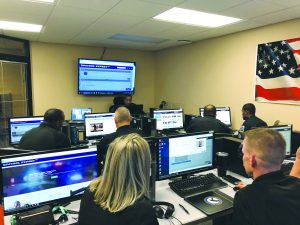
“Simulation-based learning can be the way to develop… knowledge, skills, and attitudes, whilst protecting people from unnecessary risks. Simulation-based… education can be a platform for learning to mitigate ethical tensions and resolve practical dilemmas. Simulation-based training techniques, tools, and strategies can be applied in designing structured learning experiences, as well as be used as a measurement tool linked to targeted teamwork competencies and learning objectives.”
That quote comes not from a police chief but a physician, writing in a widely cited paper published in 2010 by the Journal of Emergencies, Trauma, and Shock.1
But according to simulation experts, those sentiments could just as easily apply to the law enforcement community, where simulators are an evergrowing fixture on the training landscape.
Simulators have existed in medical, military, and aviation settings for a long time, but recent technological advances have made them more readily accessible to a wider variety of sectors.
While experts emphasize that simulation should never replace any hands-on experience, the systems can provide their own unique brand of educational benefits. Proponents say they are a natural fit for law enforcement, where so many real-world skills and circumstances are challenging to recreate in a training environment.
“It doesn’t replace live training, but there’s a higher throughput; and it allows for more repetitions of behaviors and situations that need practice,” said Sean Brenke, general manager of L3 Harris Technologies, a Salt Lake City, Utah, firm that develops driver training simulations. “Afterward, it’s easy to see what you did right and what you did wrong… You develop the skill and you do it safely.”2
Of course, not all tools are created equal. Focus areas—from driving to dogs—range widely, along with price.
Behind the Wheel
For police, Brenke and L3 Harris Technologies created PatrolSim, a full-scale driving simulator specifically designed with law enforcement in mind. The simulator’s design can be configured to recreate the physical environment of many popular law enforcement vehicles.
“There is real motion, and we can mimic specific vehicle conditions,” Brenke said. “You can change them to easily simulate different kinds of weather. It’s almost better even than being inside an actual vehicle.”
PatrolSim is designed to accurately imitate a given vehicle’s physical and functional characteristics, with each simulator coming preprogrammed with a library of specs for common patrol and light vehicles. Environments are also customizable, from the inner city to a treacherous mountain pass. Drivers can be scored on more than 20 different skills, ranging from following distance and speed to siren use and operating in hazardous conditions.
According to Brenke, agencies that use PatrolSim have reported fewer accidents and improvements in fuel efficiency. The simulator has resulted in millions of dollars in cumulative savings on maintenance and operating costs, Brenke said.
“We’ve saved millions overall,” Brenke said. “So, when you talk about something paying for itself, this definitely fits that category.”
Virtual Reality
Govred Technology provides training simulators for military and law enforcement use, but they do so a little differently than other vendors. The San Mateo, California-based company leveraged the exploding field of virtual reality to create Apex Officer, a 3D, virtual reality simulator for use-of-force, de-escalation, and crisis intervention training.
“The big selling point is that it’s not a traditional flat simulator,” said Chase Dittmer, an operator with Govred. “It’s software-based and not video-based. So, there are not predetermined scenarios. The only limit is how creative the trainer is.”3
Packages are available for agencies of essentially all sizes. Each package includes a virtual reality headset and a full range of accessories, including a haptic feedback suit. Although users can easily create scenarios of their own, the package contains all necessary soft-ware and content with more than 1,000 different training scenarios.
Govred data suggest that Apex Officer is a good return on investment; Agencies have reported an average 194 percent increase in training effectiveness and a 282 percent rise in the total number of hours spent on training.
According to Dittmer, Apex Officer can be a particularly effective training tool for younger officers—but not for the reasons, like a higher technological comfort level, that one might initially suspect.
“The difference is officers will become more used to dealing with someone
who isn’t complying,” Dittmer said. “They know more about how they can de-
escalate. They know how to interact with people who have mental illnesses. This works particularly well with younger recruits because it’s not always as easy
to transfer that kind of knowledge.”
Turn Real Footage Into Training Simulations

The average law enforcement training simulation is informed by a variety of sources, including case law. One package allows agencies to use the footage captured on their own devices, such as body-worn cameras, as the basis of future training modules. That’s the key idea behind Patrol Expert, a training simulation developed by Polis Solutions, Inc., headquartered in Seattle, Washington.
“Whether it’s tactical, legal, or moral, decision-making is key,” said Jonathan Wender, PhD, Polis’s president and CEO. “The more [they] practice decision-
making, the better officers they’ll be. It’s a safe way to gain experience in a certain area so that when you have to do it in the moment, you’ll feel more prepared and are more likely to make the right decision.”4
According to Wender, Patrol Expert is the first simulation program that enables law enforcement agencies to easily convert their own video footage, be it from body-worn cameras or another device, into training scenarios. The web-based system lets users securely upload video files, then edit them with a user-friendly suite of tools to create a customized training scenario.
“Patrol Expert is fairly intuitive,” Wender said. “It functions in two ways: you can log in and complete exercises, and you can build your own content. If you have the Internet, you can use Patrol Expert. What excites us most is that you can use your own data and files to do something that’s evidence based and cost effective.”
A World of Detail
Perhaps the archetypal image of simulation training for law enforcement is a digitized version of the classic exercise that places trainees in a virtual alley and compels them to make snap judgments on who is or is not a criminal. But modern use-of-force training simulators are worlds beyond that kind of construct and, as such, can serve as a powerful complement to wider paradigm shifts in law enforcement.
The use-of-force simulator designed by VirTra, a Tempe, Arizona, provider of simulators for law enforcement, military, educational, and commercial markets, is an apt illustration.
“Blending a variety of competencies and potential challenges into a single scenario. . . is what makes the simulator such an effective tool.”
“We do so much more than what you think of with conventional use-of-force types of training,” said Lon Bartel, director of training and curriculum at VirTra. “For example, we show different dog behaviors and how to interpret them. A dog in the training scenario might be giving the officer the whale eye. We can zoom into the eyes of the dog. You can determine whether it’s scared, whether it’s aggressive, and how you can interact or not interact. So, it’s use-of-force training at its core, but it lays other foundations and builds other skills, too.”5
This spring, VirTra is planning to roll out new solutions for tourniquet training and for interacting with those who have autism. In the latter, Bartel said the deep level of detail afforded by VirTra’s simulator allows officers to become more aware of the subtle behaviors that can make a big difference in real time.
SOURCE LISTApex Officer (Govred Technology) |
“Just because someone has their hands in their pockets doesn’t mean there’s a threat,” Bartel noted. “It’s that level of detail that lets you learn how to properly respond.”
Blending a variety of competencies and potential challenges into a single scenario—not to mention the engagement naturally provided by the simulators themselves—is what makes the simulator such an effective tool.
“We see a lot of siloed training,” Bartel said. “You have firearms [training] one day, Taser another day, and so on. Everything’s split up. That’s not how people think, and you don’t get the same kind of knowledge transfer that way. In simulations, you can bring it all together.”d
Notes:
1 Fatimah Lateef, “Simulation-Based Learning: Just Like the Real Thing,” Journal of Emergencies, Trauma, and Shock 3, no. 4 (October-December 2010): 348–352.
2 Sean Brenke (general manager, L3 Harris Technologies), telephone interview, December 12, 2019.
3 Chase Dittmer (operator, Govred Technology), telephone interview, December 13, 2019.
4 Jonathan Wender (president and CEO, Polis Solutions, Inc.), telephone interview, December 11, 2019.
5 Lon Bartel (director of training and curriculum, VirTra), telephone interview, December 13, 2019.


